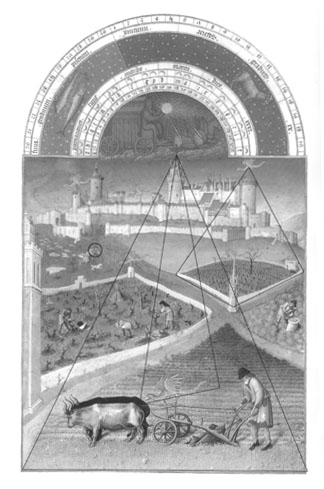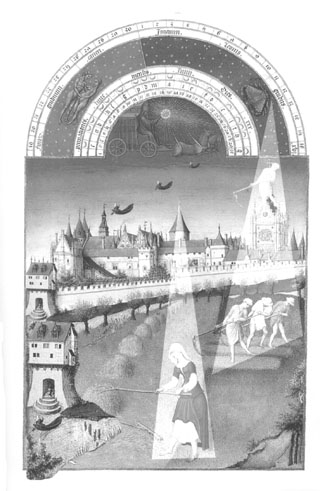
March 1
(Thus we find triads: dimension, form, and order
substance, nature, power
and took (all three brothers
or was it the single other?)
every care and every caution:
green infused with grey indicates a cult of weather
were you born here were you born
vassal, slave, your only master
with the fingers of a weaver tied back the finite branches
with the fingers of a lover let the seed sift through his fingers
who so thereafter lived here. A small dog running up to the road
in front of a flock of sheep in front of a large man carrying
something (we can’t see what) (sheaf) (shearing) holding (soft)
against him
(close).
May 1, 1410, 1 A.M.: Les Revenants
Old and on / certain nights of the Walpurgis I saw it
coming
back
a thing that lives
on bridges
suspended
“...for centuries were the exclusive privilege of the very wealthy
and of saints.”
Forgive
my apprehension
it
stood on a bridge slightly
swaying, vagary of wind,
tracery of sound that could have been wind
carved. And refused
to leave. “Here lives
what I did and cannot stop doing
“Then suddenly by the 11th or 12th century, they were all over,
sometimes alone, sometimes in great numbers, at first largely in
dreams, but soon not so confined.” (came back to us)
(and I thought I saw) (as he was
then
the army of the dead, they called it Maisnie Hellequin—soldiers, children, women, saints, by the thousands with all their attributes on
The moral was blatant (“there they go, paying”) but we were too distracted by their faces, how they hadn’t
changed at all and were more similar and were
the precision there, the choice.

May 30, 1427: Jeanne-Not-Yet-Saint with Sheep
When they eat from your hand it’s said that you’re saved
or that you saved them. You can never be sure.
What you heard. What did
And how do you know it was Saints She and Her?
And which them?
And will you agree to the musical score.
We ask you to
close your eyes and picture: it’s night (held close, black & white).
Campfires, men in armor, the army at the gate. and we haven’t
even begun to consider what we really mean by mad. If it
approaches. Seeing vs. seen.
And will make of it a king. We ask you to picture
men huddled around fire. There was so much less light then. And
it glinted their armored
bodies into black bodies of water. The way things move in
uncertain light
is not to be discounted. A touch
with the tip of a finger or an otherwise sleeping forehead, between
the eyebrows and up about half an inch. What
would you give.

June 1
Sickle one, scythe two and sweep and sheaf and sign
in the rocking field and the river whole
in its own (what hold
what
boat
of the errance of a spire (despite appearance
it’s miles
(at the door of the river) (that curves into harvest
Choir: Let us
harbor in this witness
a man
with an oar
shreds a surface
(at the door he calls a river)
a person slipping inward
How stone reigns
How hay stings
(How swing this scythe so I look a little less like
my own death) who
sings
of
of all the towers on the castle, three are red.
What are they carrying in the boat?
(List everything you could carry
away in a boat.)

October 1, 1445
How to paint a filament designed to be invisible:
How to paint a white dog against a white wall:
How a world in stages, striated, calibrated:
first you notice the person walking, the river that occupies the center of the picture, the three boats and the one man, arms raised, something hard in his hand. Such a busy world ruled by birds, held down by a stone, and what is—just behind and to the right of the first tower on the left—the moon that looks like a planet of skies against the sky and how do we live there and how do we live on air.
Executed 1440–1450, after shadows had been invented, and reflections,and lives on water, and is made of light or of its slight absence.